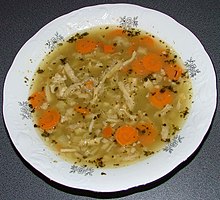 | |
| Type | Tripe soup |
|---|---|
| Place of origin | Poland |
| Associated cuisine | Polish cuisine |
Flaki (Polish: [ˈflaki] ) or flaczki ([ˈflat͡ʂki] ) is a traditional Polish tripe stew. It is one of the many Polish soups, which represent an important part of Polish cuisine. Along with bigos, żurek, and pierogi, it is one of the most notable specialities in Polish cuisine. Its name is derived from its main ingredient: thin, cleaned strips of beef tripe (in Polish: flaki - which can also be literally translated to "guts").
Etymology
The Polish name flaki, literally meaning "guts" being the plural of flak ("guts"), came from German Fleck ("spot"), from Middle High German vlëc Old High German flec/flek, from Proto-Germanic *flekka- ("spot/mark"). Flaczki, the diminutive of flaki, is also used to refer to tripe soups in Poland. Croatian fileki is a cognate. German names for tripe soups include Kuttelsuppe and Flecksuppe ("tripe soup"), as well as Saure Kutteln and Saure Flecke ("sour tripes"), as the words Kuttel, Fleck, and Kuttelfleck can all mean "tripe".
History

Flaki has been consumed on Polish territory since at least the 14th century. It is known to have been one of the favorite dishes of King Władysław II Jagiełło.
Preparation and serving
The method of preparation may vary slightly depending on the region. Some common ingredients include beef tripe, beef, bay leaf, allspice, parsley, carrot, beef broth, and spices to taste, including salt, black pepper, nutmeg, sweet paprika, and marjoram. Ready-made convenience-type equivalents of the labor-intensive flaczki are available. Sometimes pork tripe can be used instead of the beef tripe especially in the ready-made versions of the dish sold in Poland.
Tomato concentrate is sometimes added to flaki, and some may cook the tripe without a roux. A popular addition to improve the 'nobleness' is the addition of meatballs, which are often found in a regional variant known as 'flaki po warszawsku' (Warsaw-style flaki).
Ready-made flaki in cans or jars are widely available in grocery stores throughout Poland including the most popular "Flaki po Zamojsku" (Zamość-style Flaki) or "Flaki w Rosole" a version of dish in less spicy broth. Another variant of flaki, in which fowl stomach is used instead of cow's, is also known as ‘flaki drobiowe’ (poultry flaki). The soup is traditionally served during Polish weddings—as one of the "hot meals". Flaki is eaten with fresh bread, usually with bread roll. Many restaurants serve Flaki in a bowl made out of a carved loaf of fresh sourdough bread.
See also
References
- Friedel, Mieczyslaw W. (1978). This Polish blood in America's veins: sketches from the life of Polish immigrants and their descendants in America, illustrating a part of American history unknown to most Americans. Vantage Press. p. 20.
- Sietsema, Robert (16 Jun 2015). "The Offal-Eater's Handbook: Where to Eat Organs All Over the World". Eater. Retrieved 23 October 2018.
- Krzysztofek, Kazimierz (2005). "Poland: Cuisine, culture, and variety on the Wisla river". In Goldstein, Darra; Merkle, Kathrin (eds.). Culinary Cultures of Europe: Identity, Diversity and Dialogue. Council of Europe. p. 335. ISBN 92-871-5744-8. Retrieved 23 October 2018.
- Dramowicz, Dana (30 April 2009). "From Offal to Off Milk". The Krakow Post. Retrieved 23 October 2018.
- Snodgrass, Mary Ellen (2004). Encyclopedia of kitchen history. Taylor & Francis. p. 898. ISBN 9781579583804. Retrieved 8 November 2010.
Jagiello demanded fresh tripe, a favorite meal that the royal cook prepared with ginger, nutmeg, pepper, allspice, paprika, bay leaf, and marjoram.
- Smith, Andrew F. (2007). The Oxford companion to American food and drink. Oxford University Press. p. 468. ISBN 9780195307962.